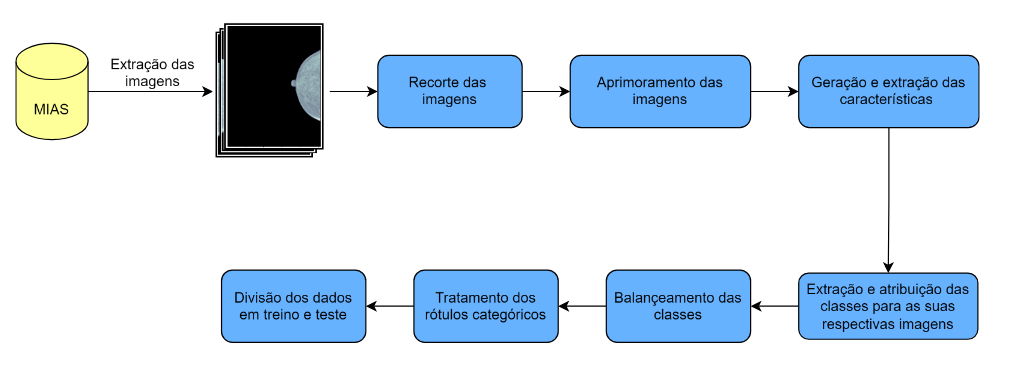Machine Learning Models in Breast Cancer Detection Using GLCM and First Order Features
DOI:
https://doi.org/10.14295/vetor.v34i2.18067Keywords:
First order features, Gray level co-occurrence matrix, Machine Learning, Breast cancer detectionAbstract
Among women, breast cancer is one of the types of cancer with the highest incidence and lethality in the world. Despite the high lethality rate, breast cancer has a high percentage of cure and favorable diagnoses when diagnosed in early stages. Mammography is considered the best method of detection, however, its images are complex, which makes the analysis susceptible to errors. One of the ways to reduce diagnostic errors is the use of computerized methods to aid diagnosis. To contribute to the accurate diagnosis of this disease, in this work, we compared three machine learning models for breast cancer detection using the MIAS mammography image database, based on features extracted from the gray level co-occurrence matrix and first order features. The models evaluated are K-Nearest neighbor (KNN), random forest and XGBoost. The result show that the tested models did not obtain result with high degree of accuracy. Among the models evaluated, XGBoost obtained the best result.
Downloads
References
I. C. B. Ohl, R. I. B. Ohl, S. R. R. Chavaglia, e R. E. Goldman, “Public actions for control of breast cancer in Brazil: integrative review,” Revista Brasileira de Enfermagem, vol. 69, no. 4, pp. 793–803, 2016. Disponível em: https://doi.org/10.1590/0034-7167.2016690424i
P. A. da Silva e S. da S. Riul, “Breast cancer: risk factors and early detection,” Revista Brasileira de Enfermagem, vol. 64, no. 6, pp. 1016–1021, 2011. Disponível em: https://doi.org/10.1590/S0034-71672011000600005
B. R. N. Matheus, “BancoWeb: base de imagens mamográficas para auxílio em avaliações de esquemas CAD,” Dissertação de Mestrado, Mestrado em Processamento de Sinais e Instrumentação, Universidade de São Paulo, São Carlos, 2010.
M. K. Santos, J. R. Ferreira Júnior, D. T. Wada, A. P. M. Tenório, M. H. N. Barbosa, e P. M. A. Marques, “Artificial intelligence, machine learning, computer-aided diagnosis, and radiomics: Advances in imaging towards to precision medicine,” Radiologia Brasileira, vol. 52, no. 6, pp. 387–396, 2019. Disponível em: https://doi.org/10.1590/0100-3984.2019.0049
C. Irawan, E. N. Ardyastiti, D. R. I. M. Setiadi, E. H. Rachmawanto, e C. A. Sari, “A survey: Effect of the number of GLCM features on classification accuracy of lasem batik images using K-nearest neighbor,” em 2018 International Seminar on Research of Information Technology and Intelligent Systems (ISRITI), Yogyakarta, Indonesia: IEEE, 2018, pp. 33–38. Disponível em: https://doi.org/10.1109/ISRITI.2018.8864443
Ş. Öztürk e B. Akdemir, “Application of Feature Extraction and Classification Methods for Histopathological Image using GLCM, LBP, LBGLCM, GLRLM and SFTA,” Procedia Computer Science, vol. 132, pp. 40–46, 2018. Disponível em: https://doi.org/10.1016/j.procs.2018.05.057
A. K. Aggarwal, “Learning Texture Features from GLCM for Classification of Brain Tumor MRI Images using Random Forest Classifier,” WSEAS Transactions on Signal Processing, vol. 18, pp. 60–63, 2022. Disponível em: https://doi.org/10.37394/232014.2022.18.8
V. P. Singh, A. Srivastava, D. Kulshreshtha, A. Chaudhary, e R. Srivastava, “Mammogram Classification Using Selected GLCM Features and Random Forest Classifier,” International Journal of Computer Science and Information Security , vol. 14, no. 6, pp. 82–87, 2016. Disponível em: https://sites.google.com/site/ijcsis/
R. A. N. Diaz, N. N. T. Swandewi, e K. D. P. Novianti, “Malignancy Determination Breast Cancer Based on Mammogram Image with K-Nearest Neighbor,” em 2019 1st International Conference on Cybernetics and Intelligent System (ICORIS), Denpasar, Indonesia: IEEE, 2019, pp. 233–237. Disponível em: https://doi.org/10.1109/ICORIS.2019.8874873
T. T. Htay e S. S. Maung, “Early Stage Breast Cancer Detection System using GLCM feature extraction and K-Nearest Neighbor (k-NN) on Mammography image,” em 18th International Symposium on Communications and Information Technologies, Bangkok, Thailand: IEEE, pp. 171–175, 2018. Disponível em: https://doi.org/10.1109/ISCIT.2018.8587920
B. S. V, “Grey Level Co-Occurrence Matrices: Generalisation and Some New Features,” International Journal of Computer Science, Engineering and Information Technology, vol. 2, no. 2, pp. 151–157, 2012. Disponível em: https://doi.org/10.5121/ijcseit.2012.2213
P. K. Mall, P. K. Singh, e D. Yadav, “GLCM based feature extraction and medical X-RAY image classification using machine learning techniques,” em 2019 IEEE Conference on Information and Communication Technology, Allahabad, India: IEEE, 2019, pp. 1–6. Disponível em: https://doi.org/10.1109/CICT48419.2019.9066263
Z. Abbas, M. U. Rehman, S. Najam, e S. M. Danish Rizvi, “An Efficient Gray-Level Co-Occurrence Matrix (GLCM) based Approach Towards Classification of Skin Lesion,” 2019 Amity International Conference on Artificial Intelligence, Dubai, United Arab Emirates: IEEE, 2019, pp. 317–320. Disponível em: https://doi.org/10.1109/AICAI.2019.8701374
L. K. Kumari e B. N. Jagadesh, “A Robust Feature Extraction Technique for Breast Cancer Detection using Digital Mammograms based on Advanced GLCM Approach,” EAI Endorsed Transactions on Pervasive Health and Technology, vol. 8, no. 30, p. e3, 2022. Disponível em: https://doi.org/10.4108/eai.11-1-2022.172813
K. C. Tatikonda, C. M. Bhuma, e S. K. Samayamantula, “The Analysis of Digital Mammograms Using HOG and GLCM Features,” 2018 9th International Conference on Computing, Communication and Networking Technologies, Bengaluru, India: IEEE, 2018, pp. 1–7. Disponível em: https://doi.org/10.1109/ICCCNT.2018.8493809
M. Pratiwi, Alexander, J. Harefa, e S. Nanda, “Mammograms Classification Using Gray-level Co-occurrence Matrix and Radial Basis Function Neural Network,” Procedia Computer Science, vol. 59, p. 83–91, 2015. Disponível em: https://doi.org/10.1016/j.procs.2015.07.340
















